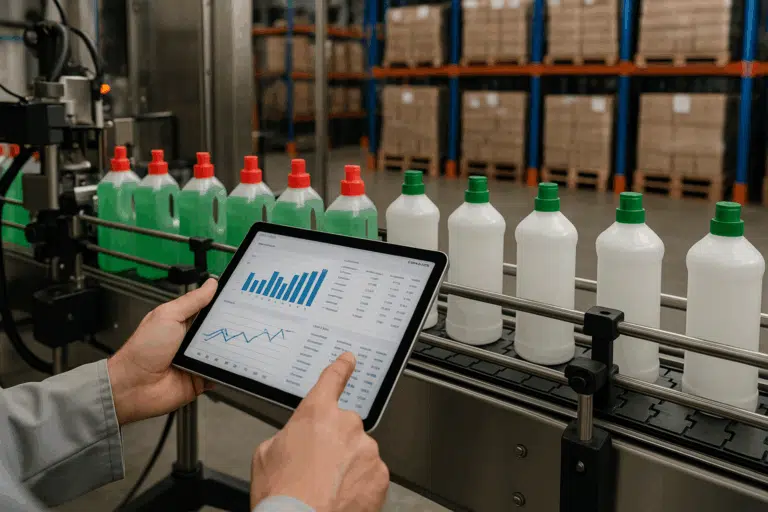What if your accounting for leases changed suddenly, affecting your tax strategy and balance sheet? The Financial Accounting Standards Board’s (FASB) new rules on Topic 842 bring this challenge. But do you know how ROU asset tax treatment under this new standard could change your financial reporting and profits?
The CPCON Group has over 25 years of experience in ROU asset accounting and fixed asset management. We’ve seen big changes in lease accounting. Now, companies must put Right-of-Use (ROU) assets and lease liabilities on the balance sheet. This change means more than just new accounting rules; it’s a chance to rethink how you manage ROU assets for taxes.
This change also means you might pay taxes later. But it also opens up ways to use tax strategies for managing ROU assets in your company.
Our team is ready to help you with these complex tax issues. Companies like Walmart are using RFID for better inventory control. We can help you follow their lead and make the most of tax benefits under ASC 842.
Table of Contents
ToggleKey Takeaways
- Understanding the updated lease accounting model under ASC 842 is crucial for companies’ financial reporting and compliance.
- Grasping the tax implications and opportunities arising from ROU asset tax treatment can reveals potential strategic advantages.
- Differences between GAAP and tax bases necessitate a careful approach to recognizing deferred tax assets and liabilities.
- State tax considerations, such as franchise and property taxes, may shift under the new lease accounting standard.
- Assessment and implementation of the updated standard are time-sensitive and require meticulous planning.
- Our expertise in RFID technology assures companies meet Walmart’s RFID mandate effectively, tooling the right asset management strategy.
The Changing Landscape of Lease Accounting

The financial world is changing fast. The introduction of ASC 842 is a big change in lease accounting. It makes companies of all sizes look at their lease strategies again. This affects everything from how they report finances to how they manage leases.
Impact of FASB’s ASU on Topic 842
The FASB update to Topic 842 brings big changes. All companies must put most leases on the balance sheet. This changes how they report finances and shows the impact of operating leases more clearly. Lessees now have a new way to account for leases. They must recognize an ROU asset and a lease liability when a lease starts.
Transition Considerations for Topic 842 Implementation
Switching to the new FASB standards is complex. Companies need to check their leases under ASC 842 rules. This might show leases that were not properly classified before. It could change financial statements, affecting profit and financial ratios.
| ASC 842 Impact | Financial Implication | Tax Consideration |
|---|---|---|
| Operating Lease Recognition | New Balance Sheet Additions | Potential Property Tax on ROU Assets |
| Finance Lease Accounting | Interest and Amortization Impact | Sales Tax Implications Based on Jurisdiction |
| Enhanced Disclosure Requirements | Increased Financial Transparency | Tracking of Book-Tax Differences |
Adapting to these changes means updating internal systems to track and report leases well. The new standards under ASC 842 need careful record-keeping and reporting. They also require understanding tax implications. Companies must handle new deferred tax assets and liabilities well to stay compliant and optimize taxes.
These ongoing changes in lease accounting mean companies must keep up with compliance and reporting. At The CPCON Group, we help businesses with these changes. We ensure they follow Topic 842 well and manage financial and tax requirements effectively.
ROU Asset Tax Treatment: What Stays the Same?
ASC 842 changed lease accounting a lot, but rou asset tax treatment stayed the same. This is key for keeping finances stable and predictable. It helps businesses balance new bookkeeping rules with tax laws.
Divergence between GAAP and Tax Treatment
ASC 842 didn’t change how federal income taxes treat leases. This makes it easier for businesses to report finances and taxes accurately. Even though GAAP and tax treatment differ, this difference helps clarify leasing strategies.
Under GAAP, a right-of-use (ROU) asset and lease liabilities go on the balance sheet. But for taxes, leases are treated differently. Knowing this helps businesses keep tax treatments consistent with the law.
Understanding the True Tax Lease Concept
In true tax lease analysis, who gets the risks and rewards of owning a lease matters. A true tax lease lets the lessor own the lease and get tax benefits. The lessee can deduct lease payments. Non-tax leases are different, making lessees take more ownership risks and affect their deductions.
Businesses need to check each lease under tax laws to classify it right. This can save money on taxes and help with making decisions on assets and leases.
| Aspect | GAAP Treatment | Tax Treatment |
|---|---|---|
| Recognition of Lease | ROU Asset and Liability Recognized | Depends on Lease Type (True Tax Lease vs Non-Tax Lease) |
| Depreciation | Depreciation of ROU Asset | Lessor claims depreciation (True Tax Lease) |
| Deductibility of Payments | Not directly relevant | Lessees can deduct lease payments (True Tax Lease) |
| Ownership Risks and Rewards | Dependent on lease type (Operating vs Finance) | Risks and rewards retained by lessor (True Tax Lease) |
This difference helps businesses understand tax implications of leasing under GAAP and tax laws. It ensures they follow the rules and manage taxes well.
Maximizing Tax Benefits for ROU Assets
At The CPCON Group, we help businesses make the most of ROU asset investments. We guide them through the complex rules to get the best tax benefits. ROU assets are key under new accounting rules and need careful handling to use tax benefits well.
For example, Company C signed a 10-year lease for a building. They recorded a right-of-use asset and a lease liability of $450, plus $20 in initial costs. With a 20% corporate tax rate, managing deferred taxes is very important.
| Item | Value | Deferred Tax Impact |
|---|---|---|
| Initial Measurement of Lease Liability | $450 | $90 DTA |
| Initial Direct Costs | $20 | $4 DTL |
| Decommissioning Liability (Company B) | $100 | $30 DTA |
Company B has a $100 decommissioning liability for its nuclear plant. With a 30% tax rate, they got a $30 deferred tax asset. This shows how important ROU asset tax treatment is for finances and taxes.
Businesses with big operating leases see a big change when these assets appear on the balance sheet. This affects how they calculate transfer prices. It’s crucial to manage deferred tax liabilities and assets well, as they vary by company structure and location.
In conclusion, The CPCON Group offers expert advice on using ROU assets for tax benefits. We help businesses with complex tax issues like managing deferred taxes. This ensures they follow the latest lease accounting rules and get the best tax outcomes.
Defining ROU Assets and Lease Liabilities

Understanding lease accounting is key, especially with ASC 842. At The CPCON Group, we help our clients, like Walmart, get it right. This keeps them in line with GAAP and helps their financial plans.
Calculating the Present Value of Future Lease Payments
Calculating the present value of future lease payments is crucial. It helps figure out the lease liability and the ROU asset value. ASC 842 says to use the lease’s own rate or your own borrowing rate if needed.
It’s important to look at total rent payables and book-to-tax differences. This affects how we start valuing ROU assets and managing lease payments.
The Basis for Right-of-Use Asset Recognition
The ROU asset is like the lease liability but with some adjustments. These adjustments include prepayments, lease incentives, and initial costs. Managing these is key to following GAAP rules.
The CPCON Group offers tailored solutions to handle these complex issues. We consider everything from tenant improvements to losses. This helps with ROU asset valuation and ensures compliance with ASC 842.
Knowing how to handle lease liability measurement and ROU asset valuation is vital. At The CPCON Group, we’re experts in lease accounting. We make sure our clients are ready for ASC 842, keeping them compliant and financially healthy.
Tax Strategies for Real Estate Investments
At The CPCON Group, we know how complex real estate asset tax planning can be. The ASC 842 standards have changed the game, especially with right-of-use assets and liabilities. It’s key for companies to update their investment property tax management plans.
Good tax strategies for real estate investments need deep knowledge and a proactive approach. With ASC 842 and the pandemic’s effects, lease negotiations are changing. Now, companies often pick shorter leases, which changes taxes and finances.
Our experts work on optimizing real estate tax impacts with custom solutions. We look at lease terms, use smart tax depreciation, and use landlord and tenant deductions.
Rental income, capital gains, and dividends from Real Estate Investment Trusts have new rules under ASC 842. Our team knows how to get the best results for our clients. Here’s a look at the financial effects of the new standards:
| Aspect | Pre-ASC 842 | Post-ASC 842 |
|---|---|---|
| Right-of-Use Asset Recording | Not Applicable | Mandatory on Balance Sheet |
| Lease Liabilities | Off-Balance Sheet | Recorded on Balance Sheet |
| Liquidity and Ratios | Not Directly Affected | Could Affect Debt Covenants |
| Lease Negotiation | Long-term Favorable | Trending Shorter Term |
Knowing and applying these new rules is key to being financially efficient and compliant. At The CPCON Group, we help our clients meet compliance and get the best financial results from their real estate.
We suggest real estate firms and investors talk to tax experts to understand these changes. Our team is here to offer strategic advice and solutions for each client’s needs.
Depreciation Tax Benefits for ROU Asset Management
ROU asset management is key in today’s lease accounting world. It’s vital for businesses to know about depreciation tax benefits. With ASC 842 changing things, companies must adjust their accounting to fit new rules.
Amortization of Leased Asset and Recognizing Interest Expense
Amortizing leases is important for getting the most from ROU asset depreciation tax benefits. By planning the amortization schedule well, companies can lower their tax bills over time. They also need to keep track of interest on leases, which is higher at first for finance leases.
For operating leases, interest costs stay the same over the lease. Knowing these details helps with tax planning and following the rules.
Expense Recognition Under Finance and Operating Leases
It’s crucial to be precise when recognizing expenses for finance and operating leases, following ASC 842. Finance leases show more expense early on, which can change profit and loss early in the lease. Operating leases spread costs out evenly over time.
Getting these classifications right is key to managing ROU assets well and understanding their financial effects.
Understanding ROU asset management helps companies follow financial rules and improve their asset and tax strategies. By using depreciation tax benefits and accurate expense tracking, companies can save money and stay competitive.
Accounting for Capital Gains on ROU Assets
Understanding capital gains on ROU assets is key, especially with tax and disposal. At The CPCON Group, we help companies with these complex issues. We aim for the best outcomes in lease transactions and managing taxes.
When selling ROU assets, figuring out the gain or loss is crucial. This is important under ASC 842 rules. These rules say gains from selling ROU assets must be counted and measured right. It’s important to consider both book and tax differences, which affect financial statements.
Capital gains can happen when an asset sells for more than its book value and still has tax deductions. These gains can lead to big tax effects, based on the lease type. For example, finance and operating leases are treated differently. Each needs a special way to handle capital gains on ROU assets.
| Item | Finance Lease | Operating Lease |
|---|---|---|
| Amortization Approach | Asset amortized separately from interest | Rent expense recognized on a straight-line basis |
| Lease Payments | Principal payments are a financing activity | All lease payments are operating activities |
| Tax Treatment | Depreciation claimable | No depreciation, only expense claim |
| Gain on Disposal | Potentially higher due to asset capitalization | Usually lower, limited to prepaid or accrued rent |
Analyzing these capital gains is key for following the rules and getting good tax results. At The CPCON Group, we use our deep knowledge to guide companies. We help manage assets well, getting better tax results and following the rules.
We also help companies use strategies like the Walmart RFID mandate. This improves asset management and inventory control. With RFID technology, tracking assets gets better, making financial reporting more accurate. Our expertise makes handling capital gains, disposal, and following rules easy and beneficial.
Handling ROU assets is more than just following rules. It’s about making smart choices for the company’s financial health. With our help, businesses can turn challenges into chances for growth and betterment.
Deciphering ROU Asset Depreciation Tax Rules
ROU asset depreciation is a big challenge for lessors and lessees. It’s key to understand it well, especially with lease accounting rules under ASC 842. The tax rules affect the lessor’s financial statements and how they handle asset accounting. It’s important to know the type of lease involved.

Derecognition of the Underlying Asset
Derecognition of the underlying asset changes a lot in lease accounting. This is true for sales-type and direct financing leases. It doesn’t just change how things look on financial statements. It changes how assets and expenses are seen.
The lessor’s financial statements show the net investment in the lease after derecognition. This affects how revenue is recognized under new tax and accounting rules.
Interest Income Increment and Payment Collection Dynamics
Collecting lease payments is key to recognizing interest income on leases. Sales-type leases focus on derecognizing the asset. Then, they focus on earning interest income as payments come in.
Operating leases keep the asset on the balance sheet. They require depreciating it over its useful life. This shows how payments and revenue are recognized.
For the CPCON Group, helping businesses with tax rules is our promise. We make sure our clients, like those getting ready for Walmart’s RFID mandate, follow their financial rules well. Our skills help with lease accounting under ASC 842 and the best way to handle ROU asset taxes. This helps firms improve their finances and reports.
State Taxes and Franchise Tax Bases Impact
We at The CPCON Group know how ASC 842 changes the game for franchise tax and tax reporting. It makes us rethink how we handle state taxes and net worth adjustments.
Lease costs over $5,000 are big deals, affecting state and local taxes. They change how we figure out taxes. Our team makes sure you get this right in your financial plans. Now, how we record leases changes the way we look at franchise taxes, which is key for tax planning.
| Aspect | Impact on Franchise Tax Base |
|---|---|
| Deferred Tax Balances for True Tax Leases | Newly created, affecting book but no tax basis |
| Deferred Tax Balances for Non-Tax Leases | Relatively smaller since leases align in book and tax |
| Sale-Leaseback Transactions | Potential new deferred tax assets/liabilities depending on tax treatment |
Changes also hit the day-to-day of businesses, especially their state and local taxes. For example, finance leases now show up as interest and amortization on the income statement. This affects how you can deduct interest in different places. It’s key for businesses to update their systems to get these taxes right.
We’re pros at handling ROU asset tax treatment. We help companies smoothly move to these new leasing rules. By getting these changes right, we protect your business from unexpected tax issues.
At The CPCON Group, we make sure your move to ASC 842 goes smoothly. We follow state laws and help you cut down on taxes. Working with us means your business can adjust and grow with these new rules.
Minimizing Taxable Gains on Rental Properties

At The CPCON Group, we use over 25 years of property management skills to help you minimize taxable gains. We do this with smart fiscal strategy and following rental property tax rules. It’s key for our clients to do well.
Fiscal Implications of Property Management
We focus on making operations cost-effective and following property tax deductions in managing real estate tax legislation. We use leasehold improvements and rental property management methods. These help cut down on taxable events and support long-term success.
Dissecting Rental Property Tax Rules
Understanding rental property tax rules is complex. We use our knowledge to help clients find deductions and lower taxable gains. This requires a deep grasp of current laws and their effects on properties.
We don’t just follow the rules. We also advise on changes in laws and their effects. For example, knowing about IFRS 16 and ASC Topic 842 helps us suggest the best strategies in changing financial times.
Here’s a quick look at the fiscal benefits we aim for in our strategies:
| Strategy | Expected Benefit | Related Legislation |
|---|---|---|
| Strategic depreciation scheduling | Reduction in taxable income | ASC Topic 842, IFRS 16 |
| Optimization of lease terms | Lesser liabilities on balance sheets | GAAP Financial Reporting |
| Proactive leasehold improvements | Maximization of property value and tax deductions | Section 23H |
Our goal in every strategy is to make sure we follow tax-efficient property operations. We aim to boost investment returns with smart improvements and management.
The Role of Deferred Tax Accounting in ROU Asset Reporting
The new ASC 842 lease accounting standard changes how companies report Right-of-Use (ROU) assets and lease liabilities. It focuses on deferred tax accounting. This looks at tax differences from the start of leasing.
At CPCON Group, we see that ROU assets under finance leases cause temporary tax differences. This is because the tax and accounting ways of looking at leases differ. Each lease type, short or long-term, gets a unique tax treatment under ASC 842.
Tracking temporary differences in tax is a big task. Short-term leases have simpler tax reporting than long-term ones. It’s important to know the tax basis and book basis of ROU assets. These can be very different under the new rules.
Companies must watch for changes in federal and state lease accounting rules. These changes affect how deferred tax and liabilities are shown. State taxes can vary, adding more complexity to compliance.
Deferred tax accounting is key for international reporting standards like IFRS 16. These standards add more complexity due to cross-border tax rules. Companies must quickly recognize deferred tax assets and liabilities. This is important from the first period shown.
Getting ROU assets right under the new rules is crucial. At CPCON Group, we offer the skills and tools to help with these changes. We support you from the start to full compliance, keeping your financial reports accurate.
Ensuring Compliance: ROU Asset Accounting in Tax Calculations
At The CPCON Group, we know how important it is to follow compliance in tax calculations. We adapt to new rules like ASC 842. It’s key to correctly handle deferred tax assets and liabilities for ROU assets. This keeps your tax practices strong and healthy under the latest lease accounting rules.
Reversals and Recognition of Deferred Tax Liabilities and Assets
Handling temporary differences reversal in ROU asset taxes needs special skills. We watch how these differences change over time. When we recognize a deferred tax asset or liability, it’s because of differences between book and tax values of ROU assets and lease liabilities. This careful handling makes sure our financial statements meet strict financial compliance standards. It also gives us a competitive edge.
Dual Model Approach: Finance vs. Operating Lease Classification
Understanding lease classification under ASC 842 is a challenge we easily overcome. The dual model lease approach puts leases into finance or operating types. This choice affects finance lease impacts or operating lease treatment. It changes how expenses and revenues are spread out over the lease term. This affects deferment and taxes each year. Knowing these types helps businesses plan their finances better.
We take a full approach to managing classification under ASC 842. We focus on careful checking and precise action. This keeps us in line with new rules and helps our clients smoothly switch to new standards.
| Impact Aspect | Finance Lease | Operating Lease |
|---|---|---|
| Expense Recognition Timing | Earlier Impact Due to Interest & Amortization | Linear Expense Recognition Over Lease Term |
| Tax Impact | Increased Early Expenses Reduce Taxable Income Sooner | Smoother Tax Liability Throughout Lease Term |
| Deferred Tax Dynamics | Higher Initial Deferred Tax Liabilities | More Balanced Asset-to-Liability Ratio |
At The CPCON Group, we do more than just follow lease accounting rules. We build strong partnerships. We make sure rou asset tax treatment under new lease standards is easy for you. We keep your finances strong and focused on the future.
Rental Property Investment Property Tax Deductions
At The CPCON Group, we know how key maximizing deductible expenses is for real estate investors. For those new to investment property taxation, it can seem tough. We’re here to help you use rental property tax deductions to make your investments more tax-efficient.
Our knowledge shows that smart handling of deductible expenses cuts down taxes and boosts your investment earnings. It’s about knowing what you can claim and proving it under the law.
- Depreciation: A big tax break that spreads the property cost over its life, lowering taxable income yearly.
- Repairs and Maintenance: You can deduct repairs and upkeep right away, like fixing leaks or painting, as long as they don’t increase the property’s value.
- Interest: You can deduct the interest on loans for buying or improving rental properties, a big part of your expenses.
- Property Taxes: You can fully deduct property taxes, which are a big part of your tax-saving strategies.
Imagine an office space that’s 25% of a building. It has yearly property taxes of $10,000 and insurance of $2,000. Our goal is to turn these costs into strong points for rental property tax deductions.
| Expense Type | Annual Cost | Tax Deductibility |
|---|---|---|
| Property Taxes | $10,000 | Fully Deductible |
| Insurance | $2,000 | Fully Deductible |
| Maintenance | $6,000 (over 5 years) | Fully Deductible |
These tips help you follow the rules and make the most of investment property taxation strategies.
We can make managing taxes a key part of your investment plan. Every expense can add value to your portfolio. Contact The CPCON Group today for a tax-smart investment approach.
Preparing for ASC 842 Implementation: A Timeline Approach
Starting the journey to ASC 842 compliance is big. It’s important to know the timeline and how to adapt. At The CPCON Group, we help companies change with detailed plans and tailored steps.
Early Application and Adaptation for Entities
Entities thinking about applying ASC 842 early should pay attention to the timeline. Adopting early brings big benefits, like being ready with lease accounting before it’s needed. Checking your leases carefully is key to adapting. This makes sure your systems work with the new rules.
This early move not only keeps you in line with the law. It also helps your finances and operations.
Impact Assessment and Readiness Planning
Knowing how ASC 842 will affect you is key. The CPCON Group looks at your leases to see the impact. We show you how the new rules will change your balance sheets.
Implementing ASC 842 is more than just following the law. It’s a chance to make your lease accounting better and increase financial openness.
Our experts guide you through the transition with a clear timeline. We look at transition options and check lease data for accuracy. Our plans cover everything from checking data to making final reports, so nothing is missed.
This table shows how we assess the impact:
| Assessment Area | Description | Updated Date |
|---|---|---|
| Transition practical expedients | Evaluation of policy elections affecting transition | Not Applicable |
| Data Accuracy | Completeness and correctness of lease data | July 2018 |
| Risk Management | Addressing risks when new leases are found | July 2018 |
| ASC 842 Framework Application | Determining adjustments needed for ASC 842 compliance | July 2018 |
Switching to ASC 842 needs a good plan from start to finish. The CPCON Group will help you at every step. We make sure you meet the standards and are ready for lease management challenges ahead.
The CPCON Group knows how hard it is to put the new lease accounting standard into action. This standard, made in February 2016, changed how companies handle leases. Now, almost all leases have to show right-of-use (ROU) assets and lease liabilities on the balance sheet.
Public companies had to start on January 1, 2019. Other companies followed a year later, for fiscal years after December 15, 2019. We help businesses like Walmart with these changes, especially with RFID tracking of leased assets.
Leases are now split into finance and operating leases under Topic 842. Finance leases show up on the balance sheet and are spread out over time. Operating leases don’t show up on the balance sheet but are counted as everyday expenses.
Short-term leases of 12 months or less get a special rule. They don’t need to be on the balance sheet. Instead, they are counted as expenses over the lease time. This makes managing many short-term leases easier.
Companies can start using Topic 842 early, which helps with planning and reporting. This early start is a big help for companies.
Switching to this new way of accounting uses a modified method. This method looks back at past periods and applies the new rules. It makes the change smoother but still requires a lot of work on records and reports.
| Key Topic 842 Features | Implications for Entities |
|---|---|
| Recognition of ROU assets and lease liabilities | Ensures greater transparency in financial statements |
| Exemption for short-term leases | Reduces administrative burden for managing short-term leases |
| Classification as finance or operating leases | Impacts amortization methods and expense recognition |
| Modified retrospective transition method | Allows for phased adoption and retrospective adjustments |
We work with companies like Walmart to meet RFID mandates and follow the right rou asset tax treatment. This makes sure they follow the rules, get the best tax benefits, and work better.
Conclusion
As we finish looking at how ASC 842 changed lease accounting, it’s clear the move is complex but doable with the right knowledge and plans. At The CPCON Group, we’re experts in managing fixed assets and using the latest tech, like Walmart’s RFID. This makes us great at helping clients adjust to these new rules. These new accounting standards mean more transparency and better lease management for everyone.
New rules make companies list almost all leases on their balance sheets. This changes how they see their assets and debts. We’re here to help with this, making sure companies understand lease payments and manage rou asset tax treatment well. Our detailed work and custom plans help make sure companies do well with ROU assets.
Our main goal is to help our partners be financially efficient and follow the rules. At The CPCON Group, we lead the way in making sure companies adopt ASC 842 smoothly and manage their taxes well. We know the details of the standard and see it as a chance for better lease management. We’re ready to use our data, insights, and experience to turn challenges into wins for your lease portfolios.
FAQ
What are the basic principles of ROU asset tax treatment under ASC 842?
Under ASC 842, companies must list ROU assets and lease liabilities on their balance sheets for almost all leases. The new rules don’t change how leases are taxed. The key question is if the lease is an operating or finance lease for tax purposes.
How has the FASB’s ASU on Topic 842 changed lease accounting?
Topic 842 changed lease accounting by making companies report ROU assets and lease liabilities for almost all leases. This makes a company’s financial obligations clearer. For lessors, it also changed how to classify and account for leases, affecting their accounting and taxes.
What are the transition considerations for implementing Topic 842?
To implement Topic 842, companies must check their lease contracts, update their accounting, and change their internal controls. They need to think about how it affects their financial reports, taxes, and operations. They also need to teach their accounting teams about the changes and might need to update their systems.
Is there a divergence between GAAP and tax treatment of leases under ASC 842?
Yes, there is a gap between GAAP and tax treatment of leases under ASC 842. ASC 842 changes financial reporting for leases but not for taxes. This gap can lead to differences in book and tax lease values, affecting deferred taxes.
What is a true tax lease, and how is it relevant under ASC 842?
A true tax lease is where the lessor owns the asset for tax purposes and claims tax deductions. Under ASC 842, the way leases are reported has changed. But, the rules to decide if a lease is a true tax lease for tax purposes stay the same.
How can businesses maximize tax benefits for ROU assets?
Businesses can maximize tax benefits by looking at their lease agreements for tax advantages. They should match lease accounting with tax planning to get the most deductions. This includes using depreciation rules, planning for deferred taxes, and knowing the difference between operating and finance leases.
How is the present value of future lease payments calculated under ASC 842?
The present value of future lease payments is figured out using the lease’s discount rate, if it’s available, or the lessee’s borrowing rate. This rate helps calculate the total lease liability. Then, it’s adjusted for prepayments, incentives, and initial costs to recognize the ROU asset.
What is the basis for recognizing a Right-of-Use (ROU) asset?
The ROU asset is recognized based on the initial lease liability measurement. This is then adjusted for prepayments, lease incentives, and initial costs. The ROU asset’s value includes the lease liability and these adjustments, which is then spread out over the lease term.
What are some tax strategies for real estate investments?
Tax strategies include correctly classifying properties, accelerating or deferring income, using depreciation, and managing capital gains. Investors can also deduct expenses like repairs, property taxes, and mortgage interest related to managing and maintaining real estate.
How can businesses benefit from depreciation tax benefits for ROU asset management?
Finance leases can benefit from depreciation tax benefits by depreciating the ROU asset like owned property. This leads to tax deductions over the asset’s life. Operating leases don’t allow tax depreciation but lease payments are deductible as operating expenses. Getting the lease classification right is key for accurate tax reporting and benefits.
What is the difference in expense recognition under finance and operating leases?
Finance leases require separating lease payments into interest and asset depreciation, leading to front-loaded expenses. Operating leases have a straight-line expense pattern. The lease type affects when and how much expenses are recognized in financial reports.
What are the implications of capital gains on the disposition of ROU assets?
Selling or disposing of an ROU asset can lead to capital gains tax implications. The tax treatment of gains depends on the lease’s original classification under ASC 842. Accurately calculating and reporting any gain or loss is crucial for a company’s financial and tax situation.
How does ASC 842 affect the depreciation tax rules for ROU assets?
ASC 842 changes how lessors record assets and income for certain lease types. In sales-type or direct financing leases, the asset is removed, and a net investment in the lease is recorded. This changes the depreciation schedule and tax rules. For operating leases, the asset stays on the books and is depreciated over time, following tax rules.
What is the impact of ASC 842 on state taxes and franchise tax bases?
ASC 842 could affect a company’s franchise tax base and state taxes by adding lease liabilities and ROU assets. Companies need to know state tax laws and adjust their reports to stay compliant and minimize state tax.
How can property managers minimize taxable gains on rental properties?
Property managers can lower taxable gains by using depreciation deductions, deferring income, and separating costs for different depreciation schedules. Keeping detailed records and understanding tax laws is also key.
What role does deferred tax accounting play in ROU asset reporting?
Deferred tax accounting is crucial for ROU asset reporting because it deals with differences between financial and tax lease values. These differences affect when expenses are recognized and the measurement of deferred tax assets and liabilities.
What is the importance of the finance vs. operating lease classification for tax calculations?
The finance or operating lease classification under ASC 842 is key for tax calculations. It changes when and how expenses are recognized for accounting and affects tax deductions and deferred taxes. This impacts a company’s tax strategy and compliance.
What are common rental property tax deductions for investment properties?
Common deductions include repair and maintenance costs, property taxes, mortgage interest, management fees, insurance, property and improvement depreciation, and marketing costs. Tracking these expenses well can lower taxable income from rental properties.
How are entities preparing for ASC 842 implementation and timeline?
Entities are getting ready for ASC 842 by looking at its impact on their leases and planning ahead. They consider early application benefits, update accounting processes, train teams, and change systems to meet the new standard. Managing the timeline well is key for a smooth transition.
Source Links
- Tax Impacts of the New Lease Accounting Standard ASC 842 – https://www.marcumllp.com/insights/tax-impacts-of-the-new-lease-accounting-standard-asc-842
- ASC Topic 842 changes financial, but not tax, accounting for leases – https://www.thetaxadviser.com/issues/2020/jul/asc-topic-842-tax-accounting-leases.html
- Tax Implications of the New Lease Accounting Standards: Part Two – Sikich – https://www.sikich.com/insight/tax-implications-new-lease-accounting-standards-part-two/
- Tax Accounting For Leases – https://www2.deloitte.com/us/en/pages/audit/articles/tax-accounting-for-leases.html
- PDF – https://www.pwc.com/mu/en/assets/pdf/tax-mind-edition-june.pdf
- PDF – https://www.bdo.com/getmedia/06d6a000-0e87-46c2-994d-09628ddf248e/Tech_Lease-Accounting-Guide_brochure_10-18_WEB.pdf?ext=.pdf
- Tax Considerations of New Lease Accounting Rule ASC 842 – https://www.eisneramper.com/insights/tax/lease-accounting-rule-asc-842-tax-1219/
- Recognising deferred tax on leases – Illustrative examples – https://assets.kpmg.com/content/dam/kpmg/xx/pdf/2021/05/recognising-deferred-tax-leases-illustrative-example-may-2021.pdf
- Tax Implications of the New Lease Accounting Rules – https://www.grfcpa.com/resource/tax-implications-of-the-new-lease-accounting-rules/
- Tax Impacts on Leases under ASC 842 – https://www.pbmares.com/tax-impacts-leases-under-asc-842/
- Right-of-Use Assets (ROU) & Lease Liabilities | Visual Lease – https://visuallease.com/guide-to-right-of-use-assets-and-lease-liabilities-under-asc-842/
- Tax Implications of ASC Topic 842 on Lease Accounting – https://www.jmco.com/articles/real-estate/tax-implications-asc-topic-842-leases/
- ASC 842 Lease Accounting for Tenants and Landlords – https://www.withum.com/resources/asc-842-lease-accounting-for-tenants-and-landlords/
- Tax Planning Tips for Real Estate Investors – https://rosentaxlaw.com/tax-planning-tips-for-real-estate-investors/
- 2.2.8. Properties held under leases – https://viewpoint.pwc.com/content/pwc-madison/ditaroot/gx/en/pwc/industry/industry_INT/industry_INT/real_estate__1_INT/Applying-IFRS-for-the-real-est/2_Acquisition_or_construction_of_real_estate/2_2_0_Definition_and_classification/2_2_8_Properties_held_under_leases.html
- Tax Alert – IFRS 16 – Leases: Tax implications of this new leasing standard – https://www.pwc.com/ug/en/assets/pdf/tax-implications-of-this-new-leasing-standard.pdf
- Tax Considerations in Accounting for Right-of-Use Asset – Forvis Mazars – Nigeria – https://www.forvismazars.com/ng/en/insights/forvis-mazars-insights/tax-considerations-in-accounting
- Will Implementing ASC 842, Leases, Impact Your Taxes? – https://www.cohencpa.com/knowledge-center/insights/october-2021/will-implementing-asc-842-leases-impact-your-taxes
- Key tax impacts from the new leasing standard | Grant Thornton – https://www.grantthornton.com/insights/alerts/tax/2022/insights/key-tax-impacts-from-the-new-leasing-standard
- Tax Implications of the New Lease Accounting Standards: Part One – Sikich – https://www.sikich.com/insight/tax-implications-new-lease-accounting-standards-part-one/
- The Impact of ASC 842 on Corporate Taxes – https://www.occupier.com/blog/impact-asc-842-corporate-taxes/
- A Closer Look at the Tax Implications for Leasing – https://www.cbiz.com/insights/articles/article-details/a-closer-look-at-the-tax-implications-for-leasing-article
- Operating Leases, IFRS 16 and Tax: A Basic Guide — Accounting Weekly – https://www.accountingweekly.com/tax/operating-leases-ifrs16-tax
- How New Lease Accounting Rules May Impact Landlords and Tenants – https://www.gggllp.com/how-new-lease-accounting-rules-may-impact-landlords-and-tenants/
- Recognising deferred tax on leases – https://kpmg.com/xx/en/home/insights/2021/05/deferred-tax-recognition-lease-assets-liabilities-amendments-ias12.html
- o – https://www.bdo.com/getmedia/b7fda31c-b70b-4828-873a-54204404d8a0/ASSR_Accounting-for-Leases-Under-ASC-842_Chapter-3_Practice-Aid.pdf?ext=.pdf
- New Lease Accounting Standard (ASC 842 and IFRS 16): CAM and Taxes – https://www.gaapdynamics.com/insights/blog/2017/06/27/new-lease-accounting-standard-asc-842-and-ifrs-16-cam-and-taxes/
- Guide to auditing the implementation of ASC 842, Leases – https://assets.ey.com/content/dam/ey-sites/ey-com/ja_jp/topics/sec-and-us-gaap-weekly-update/2018/pdf/ey-gaap-weekly-update-2018-09-27-02.pdf
- 4.2 Initial recognition and measurement – lessee – https://viewpoint.pwc.com/dt/us/en/pwc/accounting_guides/leases/leases__4_US/chapter_4_accounting_US/42_initial_recogniti_US.html
- Right-of-Use Asset & Lease Liability Explained w/ Example – https://finquery.com/blog/right-of-use-asset-lease-liability-asc-842-ifrs-16-gasb-87/
- ASC 842 Lease Standard: Understanding the Impact on Not-for-Profit Financial Statements – Hawkins Ash CPAs – https://www.hawkinsash.cpa/asc-842-lease-standard-understanding-the-impact-on-not-for-profit-financial-statements/
- PDF – https://us.aicpa.org/content/dam/aicpa/interestareas/centerforplainenglishaccounting/resources/2023/cpea-january-2023-report-review-engagements-implementation-of-the-new-lease-standard.pdf



























